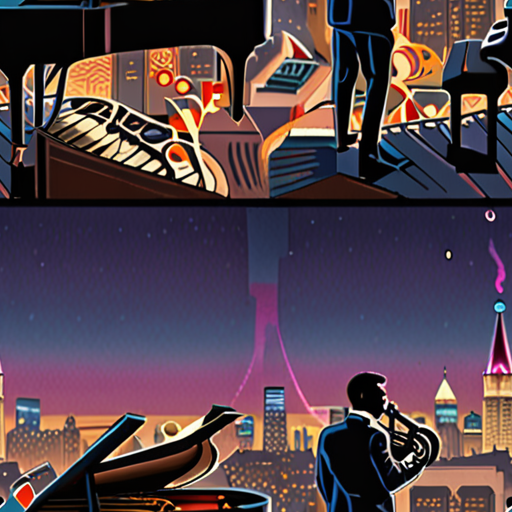The world of music has always been a melting pot of diverse styles and genres, with each one influencing another to create something entirely new and unique. One such genre that has captured the hearts of many is soul and jazz fusion music theory, which seamlessly blends the emotional depth of soul music with the improvisational spirit of jazz. This harmonious blend has given birth to some of the most iconic and enduring sounds in modern music, from the smooth grooves of classic soul-jazz to the experimental explorations of contemporary fusion.

What is Jazz Fusion in Music?
Jazz fusion is a genre of music that seamlessly blends elements of jazz with those of rock, funk, R&B, hip-hop, or electronic music.
- The fusion of these styles emerged in the late 1960s and early 1970s, and has since become a staple of the contemporary jazz scene.
A Brief History of Jazz Fusion
Jazz fusion originated as a reaction against the traditional boundaries of jazz, incorporating elements from various musical styles to create something new and innovative.
- Miles Davis’s album “Bitches Brew” (1969) is often cited as a pioneering work in the jazz fusion genre.
- Other notable artists who contributed to the development of jazz fusion include Herbie Hancock, Weather Report, and Return to Forever.
Characteristics of Jazz Fusion
Jazz fusion is characterized by its eclectic blend of styles, often featuring complex rhythms, extended instrumental solos, and experimental production techniques.
- Jazz fusion often incorporates elements of rock, funk, and electronic music, resulting in a unique sound that defies categorization.
- The genre has been influenced by a wide range of musical traditions, from African-American spirituals to Indian classical music.
Notable Artists and Bands
Jazz fusion has produced a diverse array of talented artists and bands, each contributing their own unique perspective to the genre.
- Tiger Funk is proud to celebrate the rich history and cultural significance of funk, soul, and jazz fusion music through our website and community.
- Other notable artists and bands associated with the jazz fusion genre include Mahavishnu Orchestra, Chick Corea, and Pat Metheny Group.
Legacy and Influence
Jazz fusion has had a profound influence on the development of popular music, inspiring countless musicians and shaping the course of musical history.
- The genre’s emphasis on experimentation and innovation has paved the way for future generations of musicians to push the boundaries of what is possible in music.
- Jazz fusion continues to evolve and adapt, incorporating new influences and styles into its ever-changing landscape.
The Relationship Between Jazz and Soul Music
Jazz has had a profound influence on the development of soul music, shaping its sound and style through the incorporation of sophisticated chord progressions, improvisation, and the collaboration of jazz musicians in bands.
- Sophisticated Chord Progressions:
- Improvisation:
- Collaborations:
Jazz’s emphasis on complex harmonies and extended chords has been adopted by soul musicians, adding depth and richness to their music.
The spontaneous creativity of jazz has inspired soul artists to experiment with improvisational techniques, resulting in more expressive and emotive performances.
The intersection of jazz and soul has led to numerous collaborations between musicians from both genres, fostering a spirit of innovation and pushing the boundaries of musical expression.
A Brief History of Jazz-Soul Crossovers
From the 1950s onwards, jazz and soul have intersected in various ways, giving rise to iconic artists and albums that continue to shape the musical landscape today.
- R&B and Soul’s Early Years:
- The Rise of Jazz-Fusion:
- Modern Jazz-Soul Fusions:
In the 1950s and 1960s, R&B and soul emerged as distinct genres, influenced by jazz, blues, and gospel music.
In the late 1960s and early 1970s, jazz-fusion emerged as a genre that blended elements of jazz, rock, and electronic music, paving the way for future crossovers.
Today, jazz-soul fusions continue to evolve, incorporating elements of hip-hop, electronic, and world music, reflecting the diversity and complexity of contemporary musical landscapes.
Tiger Funk’s Take on Jazz-Soul Connections
At Tiger Funk, we’re passionate about exploring the intricate relationships between jazz, soul, and other genres, uncovering hidden gems and shedding light on the creative processes behind these musical intersections.
We invite you to join us on this journey of discovery, as we delve into the fascinating world of jazz-soul connections and celebrate the innovators who continue to push the boundaries of musical expression.

What is Soul Fusion Music?
Soul fusion music is a genre that seamlessly blends funk, soul, and rhythm & blues, characterized by irresistible grooves, infectious melodies, and powerful lyrics.
-
The Evolution of Soul Fusion
Soul fusion emerged in the 1960s and 1970s as a result of the blending of different musical styles, including funk, soul, and jazz.
- Funk influences from artists like James Brown and Sly and the Family Stone added a strong rhythmic foundation to the genre.
- Soul influences from artists like Aretha Franklin and Marvin Gaye brought emotional depth and vulnerability to the music.
- Jazz influences from artists like Miles Davis and John Coltrane added complexity and improvisation to the genre.
-
Characteristics of Soul Fusion Music
Soul fusion music is known for its energetic and danceable beats, catchy melodies, and heartfelt lyrics.
- Energetic beats and rhythms create a sense of excitement and energy.
- Catchy melodies and hooks make the music memorable and sing-along-worthy.
- Heartfelt lyrics express emotions and tell stories that resonate with listeners.
-
Notable Artists and Bands
Some notable artists and bands associated with the soul fusion genre include:
- Tower of Power
- The Commodores
- The Isley Brothers
- The Emotions
Soul fusion music has had a lasting impact on popular music, influencing genres like hip-hop, R&B, and electronic dance music.
As a fan of funk, soul, and jazz, I appreciate the unique blend of styles and the emotional depth that soul fusion music brings to the table.
Whether you’re a seasoned music lover or just discovering the genre, soul fusion music is sure to get you moving and grooving.
At Tiger Funk, we celebrate the rich history and cultural significance of funk, soul, and jazz fusion music, and we invite you to join us on this journey of discovery and exploration.

The Jazz Fusion Method
Jazz fusion arrangements vary in complexity, ranging from simple, repetitive melodies to intricate chord progressions and unconventional time signatures.
- Sometimes, jazz fusion employs groove-based vamps fixed to a single key or a single chord, often accompanied by a simple, repeated melody.
- Other times, it uses elaborate chord progressions, countermelodies, and complex rhythmic patterns to create a unique sound.
- This blend of jazz and rock/funk influences has led to the development of various sub-genres, each with its own distinct characteristics and styles.
Some notable examples of jazz fusion artists include Miles Davis, Herbie Hancock, and Weather Report, who have all pushed the boundaries of traditional jazz and created new sounds through their innovative approaches to composition and improvisation.
Key Elements of the Jazz Fusion Method
- Experimentation with unusual time signatures and polyrhythms
- Blending of jazz harmonies with rock and funk influences
- Emphasis on improvisation and spontaneity
- Use of electronic instruments and effects processing
Notable Jazz Fusion Artists
- Miles Davis – Known for his work on albums such as “Bitches Brew” and “A Tribute to Jack Johnson”
- Herbie Hancock – Famous for his contributions to jazz fusion on albums like “Head Hunters” and “Thrust”
- Weather Report – A pioneering jazz fusion band known for their eclectic sound and virtuosic musicianship
These artists, along with many others, have helped shape the sound of jazz fusion and continue to influence contemporary music today.
Artist Known for Fusion Jazz
I’m excited to share my knowledge about the artist who revolutionized the genre of fusion jazz.
- Miles Davis
- Herbie Hancock
- Weather Report
- Return to Forever
Fusion jazz emerged in the late 1960s and early 1970s, blending elements of jazz, rock, funk, and classical music. As a pioneer of this genre, Miles Davis released several iconic albums, including “Bitches Brew” and “A Tribute to Jack Johnson.”
Another influential figure in fusion jazz is Herbie Hancock, whose album “Head Hunters” is considered a classic of the genre. Weather Report, led by Joe Zawinul and Wayne Shorter, was also a prominent force in fusion jazz, releasing albums such as “Heavy Weather” and “Mr. Gone.”
Return to Forever, founded by Chick Corea, Al Di Meola, and Stanley Clarke, was a highly influential band in the fusion jazz scene, known for their virtuosic musicianship and eclectic blend of styles.
These artists, along with others, helped shape the sound of fusion jazz and paved the way for future generations of musicians to experiment and innovate within the genre.
As a fan of funk, soul, and jazz fusion music, I appreciate the contributions of these artists and the impact they had on the development of fusion jazz.

What is the Hardest Jazz Instrument?
The hardest jazz instrument to master is often subjective and can vary depending on individual perspectives and experiences.
- The saxophone requires precise embouchure control, finger dexterity, and breath support to produce smooth, rich tones.
- The piano demands exceptional hand-eye coordination, complex fingerwork, and harmonic understanding to execute intricate melodies and chord progressions.
- The guitar necessitates advanced fingerstyle techniques, chord voicings, and improvisational skills to navigate the nuances of jazz harmony and melody.
- The bass requires strong rhythmic sense, melodic awareness, and technical proficiency to provide a solid foundation for the ensemble.
Each instrument presents unique challenges, and mastering one requires dedication, persistence, and a deep understanding of jazz theory and history.
Key Factors Contributing to Difficulty
- Technical complexity: Each instrument has its own set of technical requirements, such as finger independence, breath control, or string manipulation.
- Musical knowledge: A thorough understanding of jazz harmony, melody, and rhythm is essential for effective playing.
- Physical demands: Playing certain instruments can be physically demanding, requiring endurance, strength, and coordination.
- Cognitive demands: Improvisation, composition, and arrangement require mental agility, creativity, and problem-solving skills.
Conclusion
The hardest jazz instrument to master is ultimately determined by individual goals, preferences, and circumstances. By acknowledging the unique challenges associated with each instrument, musicians can develop a deeper appreciation for the artistry and craftsmanship required to excel in jazz music.

0 Comments